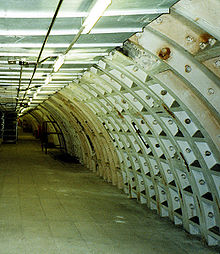- London deep-level shelters
-
The London deep-level shelters are eight deep-level air-raid shelters that were built under London Underground stations during World War II.
Contents
Background
Each tunnel consists of a pair of parallel tunnels 16 feet 6 inches (5.03 m) in diameter and 1,200 feet (370 m) long. Each tunnel is subdivided into two decks, and each shelter was designed to hold up to 8,000 people. It was planned that after the war the shelters would be used as part of new express tube lines paralleling parts of the existing Northern and Central Lines. Each tunnel is of a diameter much larger than that usually used for running tunnels, but smaller than that used for the platform tunnels, hence they were constructed at the stations that would have been bypassed on the high-speed lines. However, 16 ft running tunnels were used for the Northern City Line opened in 1904, since it had been intended to run main-line trains here (a plan not realised until 1976).
Ten shelters were planned, but only eight were completed. These are at:
- Belsize Park tube station
- Camden Town tube station
- Goodge Street tube station
- Chancery Lane tube station
- Stockwell tube station
- Clapham North tube station
- Clapham Common tube station
- Clapham South tube station
The two which were not completed were at St. Paul's tube station and Oval tube station. The working shaft for the shelter at Oval now functions as a ventilation shaft for the station.[1]
The shelters were started in 1940 and completed in 1942. They were originally all used by the government, but as bombing intensified five of them were opened to the public in 1944: Stockwell, Clapham North, Camden Town, Belsize Park and Clapham South. The Goodge Street shelter was used by General Eisenhower, and the Chancery Lane shelter was used as a communications centre.
After the war, the Goodge Street shelter continued to be used by the army until the 1950s, and the Chancery Lane shelter was converted into Kingsway telephone exchange, as well as being expanded to serve as a Cold War government shelter.
Changing the face of London
The Clapham South shelter changed the face of London in 1948. The MV Empire Windrush arrived in Tilbury in 1948 carrying 492 immigrants from Jamaica. London had a severe labour shortage after the war and the Colonial Office sought to recruit a labour force from Jamaica. An advertisement had appeared in Jamaica's Daily Gleaner on 13 April 1948 offering transport to the UK, for a fare of £28.10s (£28.50), for anyone who wanted to come to work in the UK. At that time, there were no immigration restrictions for citizens of one part of the British Empire moving to another part. The Windrush was quickly filled. As there was no accommodation for the new arrivals, the Colonial Office housed them in the deep-level shelter at Clapham South.
The nearest labour exchange to Clapham South was on Coldharbour Lane, Brixton and so the men sought jobs here. Brixton became the focus for West Indian settlement from that point onwards, with successive arrivals making their way to the nascent community in Brixton. The actual time the shelters were occupied by the immigrants from the Caribbean was relatively short, as all of the men found jobs within three weeks. However, the impact of their arrival on the area was dramatic and long-lasting, the origins of the multi-racial community in South London.
In 1998, an area of public open space in Brixton was renamed Windrush Square to commemorate the fiftieth anniversary of the arrival of the West Indians.
In popular culture
The Goodge Street shelter appeared in studio mock-up form in the 1968 BBC Doctor Who story The Web of Fear, while the real location appeared as itself in the 1988 feature film Hidden City, written and directed by Stephen Poliakoff.
The Camden Town shelter was used to represent parts of Oval tube station in the 1976 two-part story The Lights of London in the BBC television series Survivors. The director of the second episode was Pennant Roberts, who subsequently directed the 1977 Doctor Who story The Sunmakers, in which the same shelter was used for scenes set in tunnels under Pluto. Roberts subsequently worked on the BBC series Blake's 7, in which the shelter was used to for the interior of the titular artificial planet in the 1980 story Ultraworld, although the episode itself was directed by Vere Lorrimer. The shelter was also used to represent parts of a secret underground facility in the vicinity of Down Street tube station in the 2005 feature film Creep.
See also
- Civil defence centres in London
- Military citadels under London
- Subterranean London
- Blast shelter
- Air raid shelter
References
- ^ "Abandonment of St Paul's and Oval shelters". Subbrit.org.uk. http://www.subbrit.org.uk/rsg/features/deep_level_shelters/index.html. Retrieved 2010-05-24.
- Emmerson, A. and Beard, T. (2004) London's Secret Tubes, Capital Transport Publishing, ISBN 1-85414-283-6
External links
Categories:- 1940s architecture
- London infrastructure
- Subterranean London
Wikimedia Foundation. 2010.



